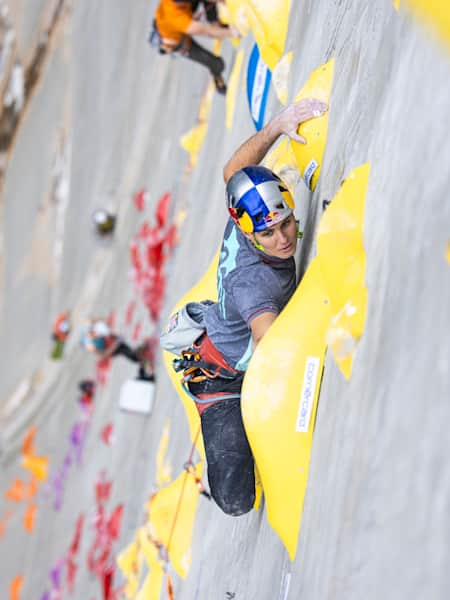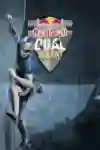First held in 2022, Red Bull Dual Ascent is an outdoor climbing competition which is breaking boundaries in man-made-route climbing events. Where most climbing gyms top out at about the height of a standard pitch of 20m, Red Bull Dual Ascent goes much higher. The event location is at Switzerland’s 220m Verzasca Dam, where the athletes climb up to a massive 180m.

36 min
Red Bull Dual Ascent
Sixteen world-class athletes on eight teams battle to be the fastest up a wall of six gruelling pitches.
And that's just one element that makes Red Bull Dual Ascent so different compared to other climbing competitions. You'll also see head-to-head multi-pitch competition on identical, artificial routes.
Here are the details of the 2024 outing, of which you can watch the final day's action live on Red Bull TV on November 2:
01
What is multi-pitch climbing?
Climbing a multi-pitch route is done in teams of two or more. One person ‘lead climbs’, the same as on a sport route, taking the risk of climbing above the bolts that would catch them if they fall, while the other belays. For the next pitch, they’ll switch, with the belayer climbing the next pitch while the first climber rests and belays. A ‘pitch’ is normally defined as what can be climbed using one standard rope, which is typically 60-70m in length, so a pitch is often around 30-40m high. The world’s most legendary multi-pitch route is probably The Nose on Yosemite National Park’s El Capitan.
02
Where does the ‘dual’ in Red Bull Dual Ascent come from?
This climbing competition offers something never seen outside of a competition climbing stage: two routes, right next to each other. Each route is made up of six pitches and 180m of climbing, and every hold is identical between the two routes – exactly the same hold in exactly the same place.
The event's twin climbing routes give Red Bull Dual Ascent its name
© Stefan Voitl/Red Bull Content Pool
03
How hard is Red Bull Dual Ascent?
The climb has been put together by a team of expert route setters. The pitches are a minimum of 6c and go up to a difficulty level of 8b on the French system. In other words: tough.
The route plays to different climbers’ strengths and weaknesses equally, and encourages innovation and for competitors to push the boundaries of what’s possible.
As renowned Brazilian climber and confirmed 2024 participant Felipe Camargo says, "The competition has been specially designed to innovate and push the boundaries of what is possible – we hope this also inspires the climbing community and newcomers to take on their own challenges."
04
Who won Red Bull Dual Ascent in the past?
The second edition of Red Bull Dual Ascent in 2023 comprised 24 climbers in teams of two. The tense final saw Jenya Kazbekova (Ukraine) and team-mate Alberto Ginés López (Spain) in a close race against Jernej and Julija Kruder (Slovenia), with the brother and sister team ultimately claiming first place.
The first edition in October of 2022 saw 16 climbers in teams of two compete. Spain's Alberto Ginés López and Slovenia’s Luka Potočar were crowned champions after beating Slovenian champion Domen Škofic and former bouldering world champion Jernej Kruder in a thrilling final.
05
How the does Red Bull Dual Ascent 2024 work?
Athletes gather at the Verzasca Dam for the competition days – including qualifications and semi-finals – on October 30-31, followed by a rest day on November 1. The event culminates on November 2 with the battle for third place as well as the grand finale
In total, there are 20 climbing athletes that take part in Red Bull Dual Ascent, divided into 10 teams. Teams are mixed, with one male and one female athlete in each.
For Dual Ascent, 20 climbers – 10 teams of two – scale the Verzasca Dam
© Raphaël Surmont / Red Bull Content Pool
Groups of two teams climb head-to-head on the identical routes using the same ropes and equipment. Routes are climbed ‘redpoint’ (flash mode), meaning it is the first time the climbers try the route; however, they receive prior information from a route demonstration shortly before.
Teams need a clean redpoint send on every pitch, on lead and following. The climbers are allowed an unlimited number of falls, where, if they do fall, they start at that same pitch again. If both teams complete all pitches, the total time to complete the route determines the winner. Time doesn’t stop until the second climber finishes the last pitch.
Teams aim to complete a continuous redpoint ascent of all pitches, alternating leads for each section. Climbers must establish each belay and have 90 minutes to finish the route. If they fail to redpoint a pitch, they can get lowered to the last belay station and retry within a maximum of five minutes, or decide to continue to climb and accept a penalty point for every violation (e.g. grabbing a quickdraw, standing on a bolt, a fall, sitting in the rope), which is then considered in the final scoring.
Winners are determined by several factors: successful redpoint ascent, penalty points, total climbing time, and height reached (if the full route isn't completed).
06
Where can I watch Red Bull Dual Ascent?
Don't miss the gripping action. You can watch the grand finale of Red Bull Dual Ascent 2024 live on Red Bull TV on November 2.
Stay up to date with more info on the format, athletes and beyond here: Red Bull Dual Ascent 2024.
07
Where have we seen the Verzasca Dam before?
Your eyes aren’t deceiving you – yes, the Verzasca Dam looks familiar. It’s been in a number of films, most famously in the James Bond film Goldeneye, where Bond bungee jumps off it. The dam holds back 23m cubic feet of water, and allows flow of 46,000 cubic feet per second (that’s a lot!) into the Lago di Vogorno, producing 234GWh of power per year.
Be sure to download the free Red Bull TV app and watch unmissable action on all your devices!
Part of this story













